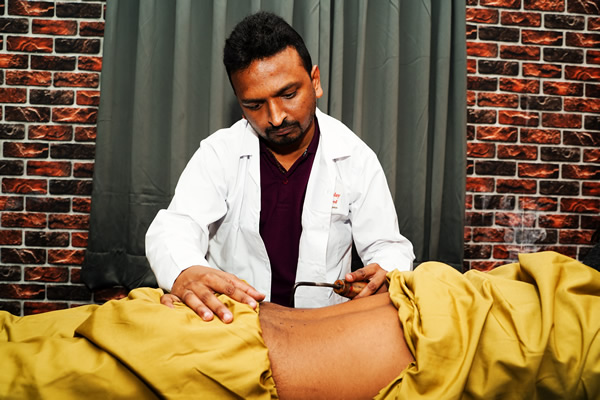Agni Karma
Agnikarma (Thermal Microcautery) is an ancient medical technique which has been well-described in Ayurveda, the Indian System of Medicine.Agnikarma is a unique para surgical procedure in ayurvedic practice. Specific degree of heat is given to a predetermined site of a body part with specialized instrument by an expert. The treatment aims to relieve pain instantaneously and also to prevent recurrence.
The treatment is done usually on OPD basis. The treatment done for Joint pains, Neurological ailments, outgrowths like Corn, Warts etc., has given miraculous results. An Indian surgeon, MaharshiSushruta, known as the father of modern surgery, documented the effectiveness of the Agnikarma (Thermal Microcautery) procedure for various musculoskeletal disorders in the ancient Ayurveda literature of Sushruta Samhita about 2500 years ago.
The Agnikarma (Thermal Microcautery) technique on the other hand, is a highly effective treatment for musculoskeletal diseases providing quick relief without side effects or complications. It is a minimally invasive cost effective procedure that can reduce the need for surgical interventions.

Procedure of Agnikarma
The procedure performed in three stages as Purva Karma, Pradhana Karma, and Paschat Karma mentioned by Acharya Sushruta.
Purva Karma
SnigdhaPicchilaAnnapana (rice and curd) was given prior to the procedure. The site of Agnikarma is washed with Triphala Kwath and wiped with dry sterilized gauze and covered with a cut sheet. Shalaka was heated up to red hot (Rajat Shalaka approximately for 3–4 min and Loha Shalaka approximately for 15 min). Ghritkumari pulp, Haridra Churna kept ready for dressing.
Pradhana Karma
In OA of the knee joint, supine position was adopted as it is comfortable to the patient. Irrespective of a specific site, Agnikarma was done at maximum tender site affected at the knee joint. The minimum space was kept between two Agnikarma points to avoid overlapping of Dagdha Vrana. After Agnikarma, fresh Ghritkumari pulp was applied on Dagdha to relieve burning pain.
Pascha Karma
After wiping of Ghritkumari pulp, honey and ghee was applied on Dagdha Vrana, after that dusting of Haridra Churna was done. Patient was observed for 30 min after procedure and advised Pathya Pathya as mentioned in Sushruta Samhita until the healing of Samyak Dagdha Vrana. Patients were strictly advised not to allow water contact at Dagdha Vrana site for 24 h.
Benefits
- It cure disease, which do not respond to any other treatment modality like Kshar Karma and other surgical interventions.
- It is choice of treatment modality for Kapha and Vata janya Vyadhi.
- Least chance of infection in treated wound.
- Least chance of recurrence of pathological phenomenon.
